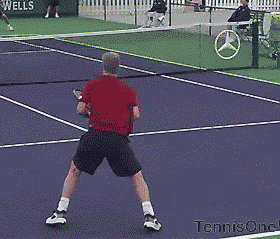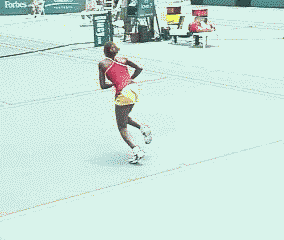|
TennisOne Lessons Learn to Play from No-Man's Land Dave Kensler - Peter Burwash International (PBI) Last month I spent four days watching the Pacific Life Open tournament in Indian Wells, California, I never cease to discover something new. Whether it is watching the matches or practice courts, there is always something to learn from the best players in the world! As I improved my game, I soon realized how impractical this advice was and how it limited me as a tennis player. Why? Because sometimes we have to play from No Man’s Land either due to the type of shot played by our opponents or to create opportunities with our own shots which allow us to move into No Man’s Land as a way to end or start to end a point.
Now having been a teaching professional for 23 years, I can honestly say I have never given any of my students the same advice I received! In fact, quite the opposite, I have told them they MUST learn to play tennis from what I prefer to call “the mid-court area” because whether they like or not, eventually they will be forced to do so. Forced Mid-Court Area Shots
Come to think of it, I think I just noted about every main shot in tennis! However, the mid-court area is not just a “reactionary” place on the tennis court but also where you can create more offensive opportunities and develop a stronger overall game.
Creating Opportunities from the Mid-Court Area
It Starts With Attitude So what should you do to improve your mid-court tennis game whether it be the “forced” or “created” shots? Most importantly, begin with the attitude it is okay to be in the mid-court area of the tennis court. Points are won and lost based on the results of balls hit, not where you are standing when you hit the ball. How to Practice Your Mid-Court Shots Serving: There is one issue pertaining to the serve and mid-court area I noticed among some of the pros at the Pacific Life Open. Those players with big serves that carry them into the court after contact (but they are not serving and volleying) sometimes, because of a quick return, are forced to hit their second shot before they are able to retreat behind the baseline. If this happens to you, then practice having to play these shots.This might require working with someone who is at or above your level of play so they can take your serve and hit it right back at you consistently.
Return of Serve: Whether through league play, a regular weekly match, or a tournament, if you know you are going to play someone who has a weak serve (First and / or second) or lacks depth with their serve, then have your teaching pro or friend hit “wimpy” serves to you while you stand inside the baseline to return them. Groundstrokes: I recommend to all my students to practice their ground strokes from five feet behind the baseline, standing on or right behind the baseline and 1-3 feet inside the baseline because you don’t always know what type of balls your opponent will be hitting to you. Also, if you play outdoors, the wind can impact where you might have to stand to play effectively. In watching the pros at the Pacific Life Open, even for just one point they may “travel” in an area from way behind the baseline to inside the baseline. Stand inside the baseline and set up a ball machine or have your pro feed you balls and practice this shot. Volley: Most players practice their volley while standing at the net but that is not the way the game is played. Set up for your first volley just behind the service line and hit your second volley while moving forward. Anyone who has played doubles while serving and volleying has had to hit these types of shots. Half-Volley: Learn to get comfortable with this shot. Set up just behind the service line like you did for the volley then have your pro or a ball machine feed the first ball at your feet. Continue moving toward the net and hit your second volley. Overhead: So often tennis players work on their overhead by standing in the ideal position, i.e. half-way between the net and service line. Yet once the match begins, lobs are often going everywhere. The pros can hit overheads from anywhere on the court and so should you! Practice moving back and hitting them in the air or after they bounce. Not every lob from your opponent will be right to you and not everyone will be over your head for a winner. It is all those “in between” lobs which you need to practice hitting overheads on.
Short Balls: These are shots whether from a return of serve or groundstroke by your opponent, force you to move inside the baseline to hit your next shot. In my opinion, you have four choices at that point, all of which you should practice:
An easy way to practice these is to set a ball machine to hit short and you can then work on all four of these options! “No Man’s Land” can be a great place to position yourself! Add the mid-court area to your tennis game and you just may improve dramatically! Your comments are welcome. Let us know what you think about Dave Kensler's article by emailing us here at TennisOne.
Dave Kensler has been teaching tennis for 23 years with Peter Burwash International (PBI). PBI contracts with resorts, hotels and clubs all over the world to direct tennis programs.The company presently has professionals working at 62 facilities in North America, Europe, Asia, Middle East, Caribbean, Pacific and Indian Ocean. During its 30 years in business, PBI tennis professionals have taught tennis in over 135 countries.For more information visit: www.pbitennis.com. |



